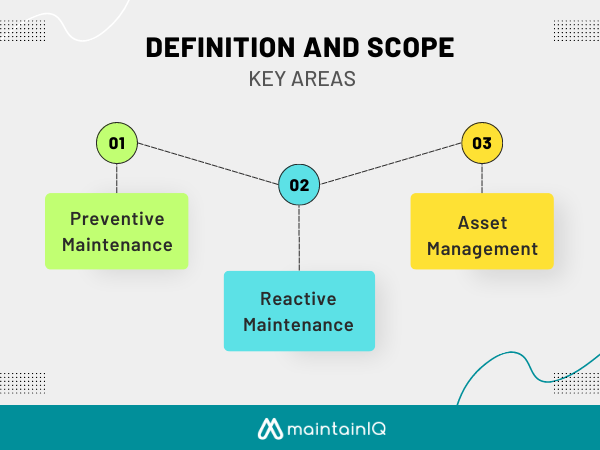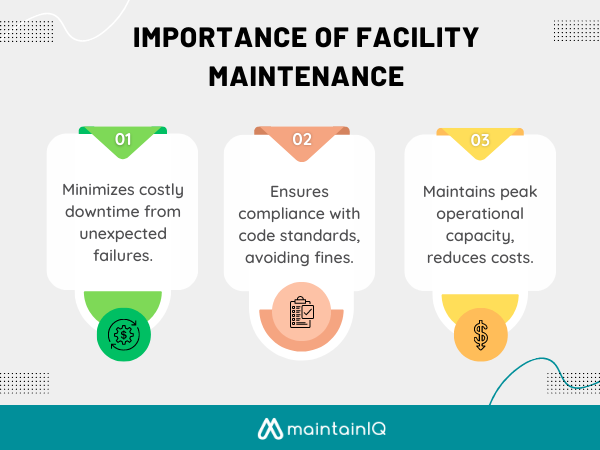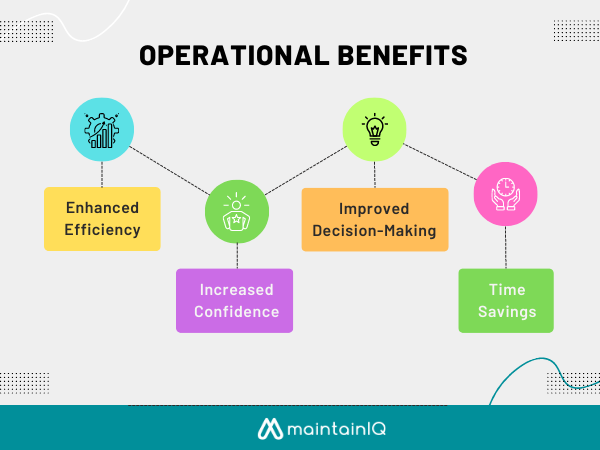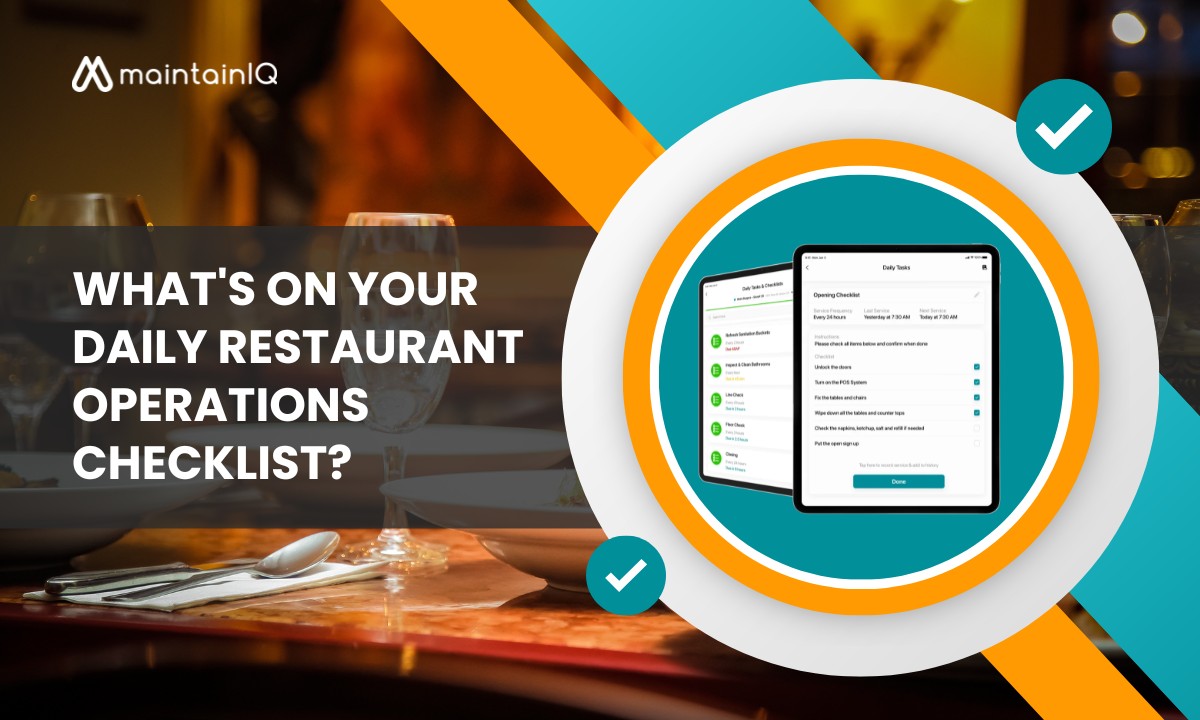As a facilities manager, keeping your building in tip-top shape is essential to its long-term success. You’re constantly juggling routine maintenance, repairs, and upgrades to ensure everything runs smoothly. But have you ever stopped to consider the importance of facility maintenance?
In this article, we’ll explore the facility maintenance’s ins and outs, from its core functions to the latest trends in digital management software.
Table of Contents
Key Takeaways
- Facility maintenance is crucial for safety, equipment lifespan, and cost reduction.
- Preventive maintenance involves regular inspections, adjustments, cleaning, and replacements to optimize performance levels.
- Adopting digital solutions like facility maintenance software increases efficiency and cost savings and improves communication among the team.
- Facility maintenance software offers comprehensive tools, real-time data, and actionable insights to streamline maintenance processes and boost operational efficiency.
Understanding Facility Maintenance
Facility maintenance encompasses all the tasks necessary to keep a building and its systems running smoothly. It’s crucial because proper upkeep not only ensures the safety of everyone inside but also helps prolong the life of your equipment while reducing overall costs.
Definition and Scope
There’s more to facility maintenance than meets the eye, as it is crucial in ensuring smooth operations and extending the life of buildings and equipment. Facility maintenance companies often use facility maintenance software to manage work orders, track assets, schedule preventive maintenance, and monitor overall performance.
Staying on top of these tasks ensures your facilities are well-maintained and functioning at peak capacity. Within the scope of facility maintenance, several key areas require attention:

- Preventive Maintenance: Regularly scheduled inspections and upkeep of all systems within a building, including HVAC systems, electrical components, plumbing fixtures, and structural elements.
- Reactive Maintenance: Addressing issues as they arise to minimize downtime and maintain productivity levels within your facility.
- Asset Management: Tracking equipment lifecycles from procurement through disposal to optimize resource allocation while minimizing costs.
Importance of Facility Maintenance

Regularly inspecting and repairing potential problems can minimize the risk of costly downtime due to unexpected failures. Moreover, adhering to code compliance standards ensures that your facility remains in good standing with local authorities, avoiding fines and penalties that could negatively impact your business.
To achieve this level of maintenance excellence, developing a comprehensive plan that covers all aspects of your facility, from HVAC systems and plumbing to landscaping and pest control, is essential. This requires strong organizational skills and an understanding of the specific needs and requirements unique to each area within your property.
Functions of Facility Maintenance
As you delve into facility maintenance, it’s crucial to understand the primary functions that ensure a well-maintained facility. These functions include routine maintenance and preventive maintenance.
So, let’s begin exploring these essential aspects of facility upkeep and how they contribute to the overall success of your operations.
Routine Maintenance

Regularly performing routine maintenance ensures the longevity and efficiency of your facility’s systems and equipment. This saves you time and money in the long run and keeps everything running smoothly for occupants and staff.
Regular inspections, cleaning, and servicing of HVAC systems, plumbing, electrical components, lighting fixtures, and other essential elements will help prevent costly breakdowns or failures.
To master routine maintenance, developing a comprehensive preventative plan outlining each task’s frequency and necessary steps is crucial. This may involve creating checklists to follow during inspections or scheduling regular service appointments with professionals who specialize in maintaining specific systems.
Don’t forget about seasonal considerations; some maintenance tasks are best performed at certain times of the year to maximize their effectiveness. For example, inspecting roofs before winter weather hits could save you from dealing with leaks caused by ice dams or excessive snow buildup.
Preventive Maintenance
When proactive with preventive maintenance, you’ll save time and money and keep your building running smoothly and safely for everyone inside.
Preventive maintenance involves regularly scheduled inspections, adjustments, cleaning, and replacements to ensure your facility’s equipment operates efficiently and at optimal performance. This type of maintenance helps identify potential issues before they escalate into costly breakdowns or, even worse, accidents that can cause injuries or property damage.
By adhering to a well-planned preventive maintenance schedule, you can minimize downtime, extend the lifespan of your assets, reduce energy consumption, and provide a safe environment for occupants.
Transition to Digital: The Rise of Facility Maintenance Software
As you manage the upkeep of your facilities, have you considered utilizing Facility Maintenance Software? This innovative technology streamlines maintenance tasks by consolidating work orders, inventory management, and preventive maintenance schedules into an organized system.
What is Facility Maintenance Software?

You’ll find that facility maintenance software is a game-changer, streamlining the management of buildings, equipment, and assets to ensure optimal performance and longevity. This type of software allows you to schedule preventive maintenance tasks, track work orders, manage inventory levels, and generate detailed reports on the overall health of your facilities. By automating many of these processes, you can reduce human error and improve efficiency in your operations.
A well-designed tool should be user-friendly and offer customized options tailored to your industry requirements. Here’s a simple table highlighting some essential components to look for:
| Feature | Why It Matters |
| Preventive Maintenance Scheduling | Automate routine tasks to reduce downtime and extend asset life |
| Work Order Management | Efficiently track progress on repairs and maintenance requests. |
| Inventory Management | Monitor stock levels to avoid running out of critical supplies. |
| Reporting & Analytics | Gain insights into trends to identify areas for improvement or potential cost savings. |
Investing in a comprehensive facility maintenance software solution that includes these features (and more), you’ll be well-equipped to master the art of managing your facilities effectively while minimizing costs and maximizing productivity.
Key Features and Benefits

Now that you’ve got a basic understanding of facility maintenance software let’s dive deeper into the key features and benefits that make it an essential tool for managing your facility effectively.
These systems help you optimize your maintenance tasks, streamline communication, and save time and money by increasing efficiency.
One of the main features of such software is its ability to automate preventive maintenance schedules. This ensures that your equipment stays in top condition, preventing costly breakdowns and reducing downtime.
Additionally, these programs can generate detailed reports on asset performance, allowing you to identify trends and make informed decisions about repairs or replacements.
The centralized system also simplifies work order management by allowing technicians to access relevant information quickly, receive notifications about new tasks, and update job statuses in real time.
Another significant benefit is improved inventory control. With accurate tracking of spare parts usage and automated reordering processes, you’ll never run out of crucial components when they are needed most.
Our Facility Maintenance Management Software: A Comprehensive Solution
Discover the comprehensive solution offered by our Facility Maintenance Management Software. It’s designed to streamline your maintenance processes and boost operational efficiency.
Features Overview

Let’s dive into the essential features of facility maintenance, making your experience more enjoyable and relatable. A robust facility maintenance management software should offer comprehensive tools to streamline your maintenance processes while providing actionable insights. These tools may include work order management, asset tracking, preventive maintenance scheduling, inventory management, and reporting capabilities.
All these functionalities in one place allow you to keep track of your assets’ life cycle efficiently while reducing downtime and extending their useful life. One feature you’ll find particularly helpful is the ability to create custom preventive maintenance schedules based on time or usage triggers. This ensures that critical equipment receives the proper care before problems arise, saving you time and money on costly repairs.
Additionally, an intuitive dashboard provides real-time data on key performance indicators (KPIs) such as work orders completed, asset health status, and inventory levels, giving you a clear picture of your facility’s overall performance at a glance. Your operations will run smoother as you continue mastering these tools within your software solution. They will increase your confidence in effectively managing any challenges with maintaining a top-notch facility.
Operational Benefits

You’ll quickly see the operational benefits of implementing comprehensive facility maintenance management software as it transforms your daily tasks into a well-orchestrated symphony of efficiency and productivity.
Gone are the days of scrambling to find information on equipment repairs or remembering when you last scheduled preventative maintenance for your assets. With an organized, centralized system, you can easily access detailed records and historical data on each piece of equipment. This lets you make informed decisions about repair versus replacement and ensures that every component operates at peak performance.
Additionally, real-time updates on work orders, inventory levels, and technician schedules will enable you to plan effectively and allocate resources where needed most. But that’s not all – you can free up valuable time for your team by automating routine processes such as scheduling preventative maintenance tasks and generating work orders based on preset triggers. This allows them to focus on more strategic initiatives or confidently tackle complex projects.
Conclusion
In conclusion, facility maintenance plays a significant role in keeping your property running smoothly. You’ll be better equipped to manage your assets by understanding its importance and functions.
Frequently Asked Questions
What is the concept of facility maintenance?
Facility maintenance refers to the upkeep of a building, equipment, or infrastructure to ensure optimal functionality, safety, and efficiency. It includes preventive, corrective, and emergency repairs.
What are the types of facility maintenance?
Types of facility maintenance include preventive maintenance, corrective maintenance, emergency maintenance, and deferred maintenance. Each type addresses different needs and issues.
What is the main goal of facility maintenance?
The main goal of facility maintenance is to maintain a safe, efficient, and comfortable environment for the occupants while maximizing the lifespan of equipment and infrastructure.
What are the key concepts of facility management?
Key concepts of facility management include strategic planning, space and asset management, health and safety, environmental sustainability, and resource allocation.
What is the difference between facilities management and facilities maintenance?
Facilities management focuses on the overall management of the building, including operations and maintenance, while facilities maintenance refers specifically to the upkeep of the building and its equipment.
Helpful Resources:
- Facility Maintenance – https://en.wikipedia.org/wiki/Facility_management
- Facility Focus on Equipment Maintenance – https://www.buildings.com/building-systems-om/article/33001115/facility-focus-on-equipment-maintenance
- The Facility Management Perspective- https://www.issa.com/articles/the-facility-management-perspective
- The Future of Facility Maintenance: Trends and Challenges – https://facilityexecutive.com/trends-shaping-the-future-of-the-facility-management-market/











